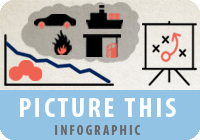
Effective January 1, 2024, Santa Barbara County’s designation for the State ozone standards was changed from “nonattainment” to “nonattainment-transitional.” Additional information on the change in designation is available at the California Air Resources Board’s website.
Our air quality attainment plans provide an overview of our air quality and sources of air pollution, and identify the pollution-control measures needed to meet clean air standards. In Santa Barbara County, our plans have focused on attaining and maintaining both the state and federal ozone standards. These plans influence a range of activities such as the development of our rules and regulations, transportation planning, and the allocation of funds for air quality projects. Read on to find out more about our air quality attainment plans, or:
- View the Final 2023 Exceptional Events Mitigation Plan
- View the Final 2022 Ozone Plan.
- View the Final 2019 Ozone Plan.
- View the Final 2016 Ozone Plan. Due to the change in designation to nonattainment-transitional, the 2016 Ozone Plan’s control measure implementation schedule was revised: View the August 2017 Report.
- View the Final 2013 Clean Air Plan.
- View the Final 2010 Clean Air Plan and the Final 2010 Environmental Impact Report (EIR).
- View the Final 2007 Clean Air Plan webpage.
- View the Final 2004 Clean Air Plan.
- View the Final 2001 Clean Air Plan webpage. This plan meets the requirements of both the Federal Clean Air Act and the California Clean Air Act and has been approved by state and federal agencies.
- View the Final 1998 Clean Air Plan.
The Process
The U.S. Environmental Protection Agency (EPA) and the California Air Resources Board (CARB) develop and implement air quality standards to protect public health. These agencies determine if our county meets or “attains” the air quality standards by using the ambient air monitoring data collected at our monitoring stations. Our county’s attainment designation drives our clean air planning process, as it sets mandates and schedules to achieve additional emissions reductions from the various emission sources within the County.
Working closely with the District Community Advisory Council and the Santa Barbara County Association of Governments (SBCAG), District staff develop plans consistent with the California Clean Air Act and state/federal guidelines. The plans are brought to the District Board for adoption, and are then sent to the EPA and/or CARB for final approval. Every three years, the District is required to update the Clean Air Plan to demonstrate the progress toward attaining the state ozone standards.
What’s in a Plan
 Our air quality attainment plans include topics such as:
Our air quality attainment plans include topics such as:
- An overview of planning efforts,
- Information on our local air quality,
- An emissions inventory and emission forecasts,
- Existing and proposed stationary source control measures,
- Existing and proposed transportation control measures, and
- Public comments, and other topics as appropriate.
The Emission Inventory forecasting process sheds light on long-term issues and challenges for our county’s air quality. For example, in the 2001 Clean Air Plan, the District found that emissions from large ocean-going vessels that travel through the Santa Barbara Channel were growing at an alarming rate. This understanding was confirmed and expanded in future Clean Air Plans. As a result, the District has been working with regional, state, national, and international agencies and organizations to promote projects to reduce marine vessel emissions.
These plans also outline new rules or measures that need to be developed and implemented to reduce air pollution from stationary sources. Plans can also inform and influence transportation planning for other regional entities, such as SBCAG. Hence, these plans are comprehensive documents that are often referenced or cited in various environmental documents.
For more information, follow the links below or contact Alex Economou.

